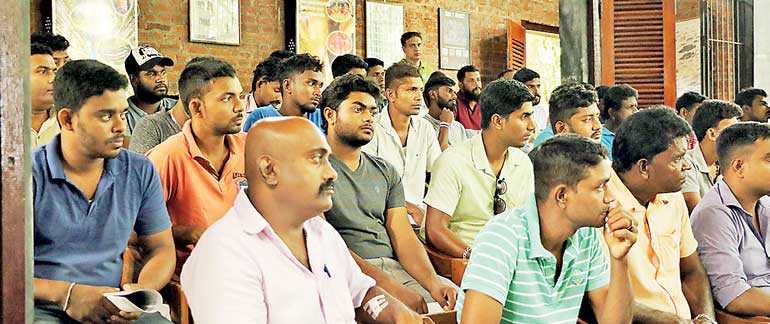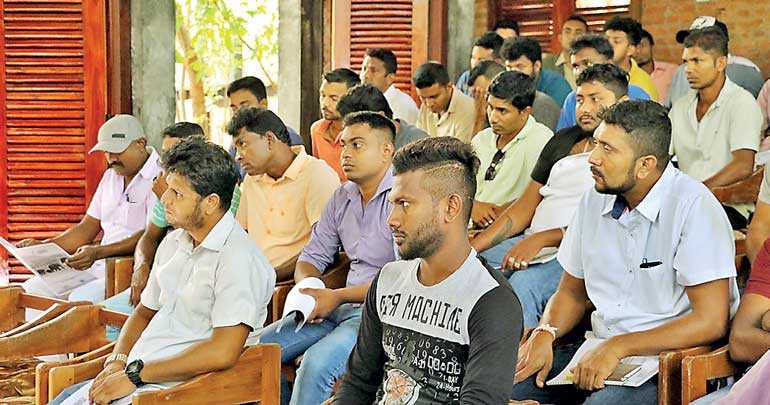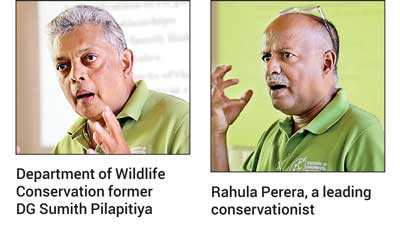Monday Jan 13, 2025
Monday Jan 13, 2025
Tuesday, 28 May 2019 00:00 - - {{hitsCtrl.values.hits}}


As Sri Lanka reels in the aftermath of a terrorist attack and, once again, travel advisories are issued by foreign governments, the tourism trade suffers the most.
Just this year Sri Lanka was acclaimed, by Lonely Planet, to be the No. 1 destination for tourism in the world. One day of evil, bloody carnage, by a few mindless fanatics, and that no longer matters. What was once a flood has turned to a trickle as tourists, understandably, heed their governments’ warnings, and those in Sri Lanka who depend on them face uncertain financial futures, as does the economy of the country as a whole. 
This is what the terrorists want – to instill fear in the people, split them into destroying each other, while crippling the economy. To defeat their wicked intent, Sri Lanka needs to return to normalcy as soon as possible, with every possible precaution taken to ensure that such an outrage does not happen again.
For this, the establishment of security, the safety of all Sri Lankans and of all visitors to this country, should be paramount. The security forces are in the process of doing this and with it, it is hoped that they will be empowered to ensure that the vigilance of the country is never allowed to slip again.
To get Sri Lanka back to No. 1 as a tourist destination, however, will require a little more effort with the addition of quality to the experience of a tourist a prerequisite for success. They will then come again and again, and encourage others to do so as well.
Training to be the best
As per a report prepared by the Sri Lanka Association of Inbound Tour Operators (SLAITO), 38% of all foreign visitors to Sri Lanka visit its National Parks. Apart from the obvious desire to see wild animals in their natural habitat, the variety of creatures and landscapes, all within a relatively small area, makes Sri Lanka one of the most accessible destinations for wildlife viewing.
In no other country can one see the largest marine mammal, the blue whale, in the morning and then, after a couple of hours drive, the largest terrestrial mammal, the elephant, in the afternoon. From montane forests to coastal dunes, from rainforests to scrub jungles, Sri Lanka has them all, all surrounded by an ocean filled with creatures of indescribable beauty.
Yet, surveys reveal that repeat visitors to the island do not visit the National Parks a second time. When questioned, their primary response was because though observing a variety of animals, in numerous places, their quality of experience was poor. The parks were overcrowded, the drivers were undisciplined, there was no standard pricing structure, no interpretation given for what they were seeing and, above all, little care for the conservation of the park and its animals.
Long before the recent attacks, in 2018, the Federation of Environmental Organisations (FEO), in collaboration with the Sri Lanka Tourism Development Authority (SLTDA) and SLAITO, with the active contribution of the Department of Wildlife Conservation (DWC), conducted Nature Interpretation Programs for jeep drivers and wildlife guides at the Minneriya, Kaudulla and Wilpattu National Parks.
The main focus of these programs was to educate jeep drivers and tourist guides not only on the natural wonders of the fauna and flora of the National Park which is the source of their livelihoods, and of explaining their beauty and intricacies of behaviour to their customers, but also on maintaining park discipline, as well as in etiquette and personal presentation. Approximately 680 jeep drivers and guides have now received this training at Minneriya and Kaudulla. In addition, approximately 70% of the jeep drivers at the Wilpattu National Park have also been trained.
To facilitate this training, FEO has had the generous assistance of several of the leading conservationists and nature interpretation experts in Sri Lanka, including Dr. Sumith Pilapitiya, Rahula Perera, Kithsiri Gunawardena, Namal Kamalgoda, Neranjana Gunatilleke, et al. Their message is added to by senior representatives from the DWC, SLTDA and SLAITO, all working together to achieve a common goal.
Walking the talk
Fundamental to the success of these programs are that the lessons learned are implemented. The DWC must monitor this within the park. This can be done electronically, at the entrance, when the National Identity Number (NIC) of the driver guide, and that of the vehicle number, is entered into the booking system, it should generate an alert to confirm that the driver has received this certification of training, and that there are no existing penalties against him.
Above all, it is the traditional patrolling that will ensure the continued maintenance of these standards; direct observation of the behaviour of drivers by officers of the DWC. In the future, they could be aided with the use of strategically placed cameras and drones.
It is also essential that other stakeholders add their weight in helping to effect this much-needed improvement of driver and visitor behaviour within National Parks. The SLTDA is the main sponsor of this series of programs and are active partners in driving this initiative forward. Tour operators will be encouraged to use only those drivers who have followed this course of training and have been awarded the course certification.
As important a partner is SLAITO. Over 90% of all tourists to Sri Lanka now use one of SLAITO’s members. They, too, will encourage the use of trained drivers. Serious breaches of behaviour WILL result in certification being withdrawn from the offending driver for a period of time, dependent on the severity of the offence. This will provide the controls needed to ensure conformity to the rules, and to change the negative perceptions now prevalent, especially among foreign visitors, of National Parks.
This program alone, however, is insufficient to raise the standards of wildlife tourism within the parks to the levels desired. Along with it should be the imposition of limits of visitation (number of vehicles per day) for every national park dependent on a scientifically determined carrying capacity for each. Along with this, there should be clearly defined rules established for visitors, guides and drivers, and mechanisms for their enforcement.
Such a Plan was developed for the Ruhuna National Park (Yala) by a special committee set up by the Prime Minister’s Office in 2016, which was comprehensive and took into account the needs of all of the stakeholders but was, regrettably, never implemented. This process could be replicated for the other parks too. The Minister of Tourism Development and Wildlife has appointed a Committee to develop a plan for increasing the quality of tourism in National Parks and, it is hoped, that they, too, will adopt and recommend the processes referred to in this report, as well as those of the Nature Interpretation Programs.
The primary agents of change
The long-term success of this program, whose ultimate intention is to preserve the wildlife and wilderness of Sri Lanka in a natural and sustainable state, depends on the will of the DWC to ensure that the principles established during this training are implemented and the controls recommended carried out fairly, and that they apply to all. They have already declared their intent that as from 1 July 2019, only commercial ‘driver guides’ who have attended these training courses, and have been awarded certification, will be permitted to take visitors into the Minneriya and Kaudulla National Parks. This is an enormous step forward in achieving the set objectives of this program, and they are to be lauded for it.
In addition, they see this as just the first step, a basic training, and once given to all jeep drivers in every National Park, will be followed by more intensive courses in specialist subjects such as birds, elephants, leopards, sloth bears, etc., along with learning English. On passing a subject, each driver will receive an additional rating, and this will be posted on a website along with all lists of drivers for a particular National Park. So, for example, if a visitor wishes to visit a park for its birdlife, they then will be able to choose a driver guide who has received that specific, additional certification.
The ultimate goal of this program, and of the measures recommended, is to provide visitors to National Parks, especially foreign visitors who bring in a large amount of revenue to the local economies and to the country, with a ‘total wildlife experience,’ an adventure they will savour and advertise to others, to make Sri Lanka second only to Africa as a place to see wildlife and beautiful, pristine wild places.
(FEO is a non-political, non-partisan organisation that provides a platform for connecting interest groups with a patriotic interest in safeguarding Sri Lanka’s natural heritage through conservation and advocacy.)